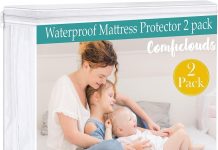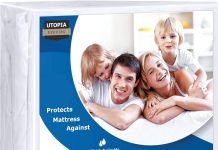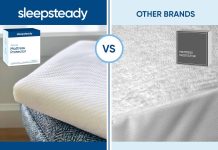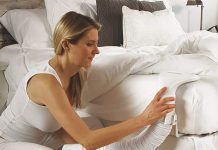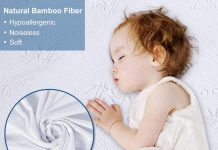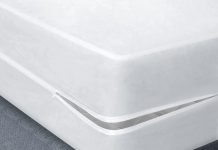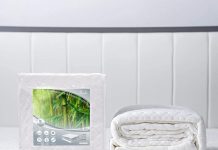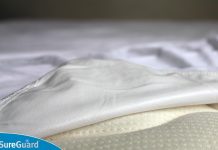In the quest for a comfortable and peaceful night’s sleep, we often find ourselves pondering over the choices we make for our bed. One of the common questions that arises is whether a mattress protector is necessary if we already have a mattress pad. It is a valid question indeed. After all, both serve the purpose of enhancing the longevity and cleanliness of our mattresses, but they do so in different ways. Let’s delve into the world of mattress protection to uncover the answer to this burning question.
Review contents
Advantages of a Mattress Pad
Extra Comfort and Cushioning
A mattress pad is a thin layer of padding that goes on top of your mattress, providing an extra level of comfort and cushioning. It adds an additional layer of softness to your bed, making it feel more plush and luxurious. Whether your mattress is too firm or you just want to enhance its overall comfort, a mattress pad is a great solution. With its extra padding, you’ll experience a cozy and cloud-like feel every night.
Protection for the Mattress
Apart from providing comfort, a mattress pad also offers valuable protection to your mattress. It serves as a barrier between your body and the mattress, preventing sweat, oils, and other bodily fluids from seeping into the mattress. This helps to keep your mattress clean and stain-free, increasing its lifespan and overall durability. Additionally, a mattress pad can help prevent the accumulation of dust and debris on your mattress, keeping it fresh and hygienic.
Advantages of a Mattress Protector
Protection from Stains and Spills
While a mattress pad offers some degree of protection, a mattress protector takes it to the next level. A mattress protector is specifically designed to guard your mattress against stains and spills. With its waterproof or water-resistant properties, it forms a protective barrier that prevents liquids from seeping into the mattress. This is particularly beneficial for those who enjoy breakfast in bed or have young children who may accidentally spill drinks or food on the bed.
Protection against Dust Mites and Allergens
One of the primary advantages of a mattress protector is its ability to safeguard against dust mites and allergens. These microscopic creatures can easily burrow into your mattress and trigger allergies or exacerbate existing respiratory conditions. A mattress protector acts as a shield, preventing dust mites from inhabiting your mattress and reducing the potential for allergens to accumulate. This is particularly crucial for individuals with allergies or asthma, as it helps create a healthier sleep environment.
Differences between Mattress Pads and Mattress Protectors
Function and Purpose
While both mattress pads and mattress protectors offer some form of protection, they serve different functions and purposes. A mattress pad primarily focuses on providing extra comfort and cushioning to enhance your sleep experience. On the other hand, a mattress protector prioritizes protecting your mattress from stains, spills, allergens, and dust mites. While there may be some overlap in their benefits, the main objective of each is distinct.
Materials and Construction
In terms of materials and construction, mattress pads are typically made from soft and padded materials such as cotton, down, or memory foam. They are designed to be plush and provide an extra layer of softness. On the other hand, mattress protectors are usually made from waterproof or water-resistant materials, such as vinyl or polyurethane, that effectively repel liquids. Some mattress protectors also feature breathable fabrics to promote air circulation and maintain a comfortable sleeping temperature.
Do I need both a Mattress Pad and a Mattress Protector?
Understanding the Role of Each
The decision to use both a mattress pad and a mattress protector depends on your specific needs and preferences. Understanding the role of each can help you make an informed choice. If you prioritize comfort and cushioning, a mattress pad alone may be sufficient. However, if protecting your mattress from stains, spills, allergens, and dust mites is crucial to you, investing in a mattress protector is highly recommended.
Specific Needs and Preferences
Consider your lifestyle, sleeping habits, and any specific concerns you may have. If you frequently consume food or beverages in bed, have young children or pets who may cause spills, or struggle with allergies or asthma, a mattress protector becomes essential. On the other hand, if you have a comfortable mattress and are solely looking to enhance its softness, a mattress pad may be all you need. Assessing your specific needs and preferences will guide you in determining whether one or both options are suitable for you.
When is a Mattress Pad Alone Sufficient?
Already Have a Mattress Protector
If you already have a mattress protector in place and are satisfied with its level of protection, a mattress pad alone can be sufficient. In this scenario, the primary goal is to add an extra layer of comfort and cushioning to your bed. A mattress pad can make a noticeable difference in the overall feel of your mattress, without compromising the protection offered by your existing mattress protector.
Only Need Additional Comfort
Sometimes, all you may seek is additional comfort and plushness without the need for extra protection. If your mattress is relatively new or in good condition, and you are content with its level of protection against spills and allergens, a mattress pad alone can provide the desired comfort upgrade. However, keep in mind that a mattress pad on its own does not offer the same level of protection as a dedicated mattress protector.
When is a Mattress Protector Essential?
Protection against Spills and Stains
If you frequently eat or drink in bed, or have young children or pets who might accidentally spill liquids, a mattress protector is essential. The waterproof or water-resistant properties of a mattress protector create a barrier that prevents liquids from seeping into your mattress, protecting it from stains and potential damage. This is especially important if you have invested in a high-quality mattress that you want to keep in pristine condition.
Allergies or Asthma
Individuals who suffer from allergies or asthma can greatly benefit from the use of a mattress protector. These protective covers act as a barrier against dust mites, pollen, pet dander, and other allergens, minimizing their impact on your sleep quality and respiratory health. A mattress protector with hypoallergenic properties can provide an extra layer of defense, creating a healthier sleep environment for those with allergy or asthma sensitivities.
Combined Use of Mattress Pad and Mattress Protectors
Added Protection and Comfort
Combining a mattress pad and a mattress protector offers the best of both worlds. Not only does it provide an extra layer of comfort and cushioning, but it also ensures comprehensive protection for your mattress. This combination offers enhanced comfort while keeping your mattress shielded from stains, spills, allergens, dust mites, and other potential threats. It’s an ideal solution for those who prioritize both comfort and mattress longevity.
Choosing the Right Combination
When using both a mattress pad and a mattress protector, consider the compatibility of the two products. Ensure that the thickness and size of the mattress pad align with the dimensions of your mattress and that it fits securely with the mattress protector. Additionally, prioritize the materials and construction of both products to ensure they complement each other and fulfill your specific comfort and protection requirements.
Factors to Consider when Selecting a Mattress Protector
Waterproof and Breathability
When selecting a mattress protector, two key factors to consider are its waterproof capabilities and breathability. A good mattress protector should effectively repel liquids, preventing them from seeping into your mattress. Look for protectors made from high-quality, waterproof materials that are also breathable. Breathability allows for optimal airflow, preventing heat and moisture buildup and ensuring a comfortable sleep environment.
Hypoallergenic Properties
For individuals with allergies or asthma, choosing a mattress protector with hypoallergenic properties is essential. Hypoallergenic materials and fabrics create a barrier against common allergens, such as dust mites, pollen, and pet dander. This helps minimize allergic reactions and ensures a healthier sleeping environment. Look for mattress protectors that are specifically marketed as hypoallergenic and allergy-friendly.
Maintenance and Cleaning
Regular Cleaning and Washing
To maintain the hygiene and longevity of your mattress protector, regular cleaning and washing are necessary. Follow the manufacturer’s instructions for cleaning, which typically involve machine washing and drying on a gentle cycle. It is recommended to regularly clean it every one to three months, or more frequently if accidents or spills occur. Keeping your mattress protector clean and fresh contributes to a healthy sleep environment.
Replacing the Mattress Protector
Over time, your mattress protector may become worn out or lose its effectiveness. It is important to monitor the condition of your mattress protector and replace it when necessary. Signs that it may be time for a replacement include visible wear and tear, reduced waterproofing abilities, and a decrease in comfort. By regularly assessing the condition of your mattress protector, you can ensure its performance and prolong the life of your mattress.
Conclusion
In conclusion, both mattress pads and mattress protectors offer distinct advantages and serve different purposes. A mattress pad enhances the comfort and cushioning of your mattress, while also providing some protection. On the other hand, a mattress protector focuses on safeguarding your mattress from stains, spills, allergens, and dust mites. Whether you need one or both depends on your specific needs, preferences, and concerns.
If you frequently consume food or beverages in bed, have young children or pets, or struggle with allergies or asthma, a mattress protector becomes essential. However, if you are solely looking to enhance the comfort of your mattress or already have a mattress protector in place, a mattress pad alone may be sufficient. Consider the function, materials, and construction of each product to determine the best solution for your sleep needs.
Remember to regularly clean and maintain your mattress protector, and replace it when necessary to ensure its effectiveness. By combining the benefits of a mattress pad and a mattress protector, you can enjoy added comfort and comprehensive mattress protection, creating a cozy and hygienic sleep environment. Sleep well and wake up feeling refreshed!

